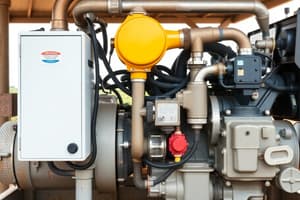Podcast
Questions and Answers
What led to the natural gasoline leak in Los Angeles on February 27, 1956?
What led to the natural gasoline leak in Los Angeles on February 27, 1956?
What was the pressure at which the ruptured natural gasoline transmission line was operating?
What was the pressure at which the ruptured natural gasoline transmission line was operating?
How far from the break in the sewer line was the natural gasoline transmission line located?
How far from the break in the sewer line was the natural gasoline transmission line located?
What significant danger arose from the flammable vapor during the incident?
What significant danger arose from the flammable vapor during the incident?
What type of gasoline was involved in the leak?
What type of gasoline was involved in the leak?
What was the estimated vapor pressure of the gasoline involved in the leak?
What was the estimated vapor pressure of the gasoline involved in the leak?
What was the response to the gas leak from various agencies?
What was the response to the gas leak from various agencies?
How many people were reported to be badly burned due to the ignition of the vapors?
How many people were reported to be badly burned due to the ignition of the vapors?
Flashcards are hidden until you start studying
Study Notes
Incident Overview
- Date and time of the incident: February 27, 1956, at 9:41 AM.
- Initial report was for a routine gas leak at Sepulveda and Cashmere Streets.
- First alarm assignment dispatched upon notification.
Emergency Response
- Battalion Chief's preliminary assessment confirmed a serious emergency.
- Significant threat identified due to a ruptured high-pressure natural gasoline line (Casing-head gasoline).
- Flammable vapors moved through sewer systems, reaching locations up to 5 miles south of the leak.
- Multiple fires ignited, resulting in four serious burn injuries.
Averted Disaster
- Authorities collectively recognized the event as potentially disastrous, mitigated by effective coordination.
- Key agencies involved: Fire Department, Police Department, Utility Companies, and other entities.
- The coordinated response prevented a major disaster despite the severity of the leak.
Cause of the Leak
- Mechanical ditch digger first damaged a 12-inch sewer line about 16 feet underground.
- Following that, the same ditch digger ruptured a 4-inch natural gasoline transmission line.
- The gasoline line was located approximately 3.5 feet below ground level, 15 feet from the sewer line breach.
- Gasoline under pressure of about 325 psi, with high levels of L.P. gas having a vapor pressure of around 60 lbs.
Studying That Suits You
Use AI to generate personalized quizzes and flashcards to suit your learning preferences.


